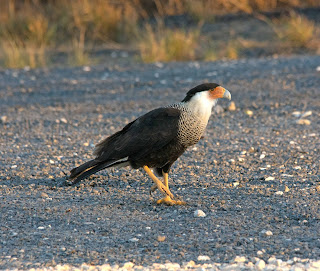Seen as early as 2002 in the Perry area, which is as far north and east as has been reported in Oklahoma, and at Red Slough in winter of 2018, the Crested Caracara gets around as an accidental or vagrant bird.
The caracara is a raptor, and very unlike a regal falcon. Even its physical attributes say that it was classified incorrectly: long legs, habits of a scavenger, rounded wingtips, and it flies low in search of prey.
Known as the northern caracara, these birds are found in scrub, deserts, grasslands, and up to ten thousand feet above sea level.
Often on foot, they capture their prey running upon the ground and overtaking it. They require a running start in order to become airborne, and once they do, their flight is strong and they can soar well, in order to scan for ground prey.
Adult Crested Caracara
January 2017, TX
As opportunists, they will join vultures at carrion, overturn rocks for insects, fish in shallow water, and eat nearly anything, even fruit. However, their bill is not useful for opening large prey, so they require a larger animal or a vulture to do that.
Since the caracara feeds upon carrion, its face is bare in order to permit cleanliness. Perching upon small trees or fenceposts, this falcon is not known for swift and acrobatic flights. It would rather scan for vultures on the way to prey.
The northern crested caracara is common in Mexico, as well as Central and northern South America. Due to recent bad weather in and around Cuba, it may not be as common there as it once was.
Stick nests are built in mesquites, palms, live oak, palmetto, cactus, shrubs, or even upon the ground if absolutely necessary. Where populations are endangered (Florida in 1987), temperature increases caused loss of habitat.

No comments:
Post a Comment